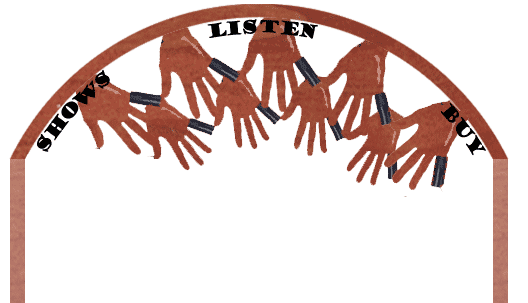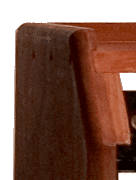Like many guitarists, Iíve always been interested in working on and building guitars. For one thing, being a left handed guitarist in a world full of right handed guitars, learning to modify instruments is almost a matter of survival. Even if I didnít have the natural inclination to cut into a guitar, I had the example of my older brother Joe, also a southpaw guitar player, who was never shy about taking things apart.
So, from reversing bridges and nuts, from developing an obsession with cutting my own glass bottleneck slides, from building a guitar or two over the years and even refretting a few guitars, it wasnít too much of a step to start attacking amps with a soldering iron. It all started in 1994 when my Fender Twin Reverb needed some maintenance, and I was curious about how to take care of it myself. So, benefiting from the 90's tube guitar amp renaissance, I started buying books about amplifiers and electronics. As I learned, it looked like it would be simple enough to build an amp. What I wanted to build was a replica of a 50's Airline amp I'd had for over 20 years. Unable to track down a schematic, I drew it myself by looking at the circuit. My first amp-building project was a copy of the Airline's preamp, and when that thing worked, I was hooked!
One of the most exciting and addictive things about building amps is the idea that you can personally go after the tone youíve always wanted, without having to rely on somebody else to provide it for youóitís the thrill of the hunt for the perfect tone. For me, the idea of using great sounding small amps had always been appealing. That way, you can get a good sound at low volume--always a challenge--and if you need to be louder just use that small amp to preamp a 50- or 100-watter. So for my first full-blown amp project, I wanted to build something fairly small. After a lot of reading and looking at lots of schematics, and with everybody jumping up and down about the tone of the '59 Bassman and the Marshall Plexi, I thought, "Why not make a low-wattage version of that basic design?" So combining the Marshall Plexi preamp with the power amp from a 60's Marshall that used two EL84's looked like the thing to do. I took this hilariously atrocious little EL84 thing called the Gregory Apollo 500 that I got for $35, stripped it down to chassis, transformer, tube sockets and terminal board, and built my "Baby Marshall" hybrid into it. The result was about the best-sounding amplifier I've ever heard, especially once I got rid of some hum problems. Click
here to see the schematic.
From there, I built and modified several amps: an EL84 Champ with no volume or tone controls, a Silverface Bassman converted to a high-gain Marshall circuit with cathode-biased 6V6's (click here to see schematic)a Fender PA 100 head converted to a Plexi/Blackface Twin hybrid (click here for the schematic), a Brown Deluxe, a Silverface Princeton converted to a one-channel cathode-biased Deluxe Reverb (12" speaker and all), reviving a blown Marshall Major and hotrodding the preamp, a
stand-alone reverb unit, and a head-to-toe re-wiring of my Twin Reverb to undo a Boogie-type mod. My brother Joe--with whom I was in a band at the
time--had a pair of identical 50-watt Acoustic tube heads that we stripped out.
I built Joe a pretty straight copy of a Plexi Marshall into one of them--using
the Acoustic transformers--with the idea that I would build myself one later.
Joe loved it, but I didn't care for it, so I lost interest in building
the other one for myself. One night in November 1999, though, I played through Joe's "Acoushall" at a jam and it sounded fantastic! I said, "What are you doing to make that sound so good?" It was that old trick of playing through both channels at the same time. That great tone I heard that night was enough inspiration to pull out the long-neglected second stripped-out Acoustic and build that second "Acoushall." Click
here to see the Acoushall schematic. In February 2001, I built
another Baby Marshall with reverb for a friend. This went into the chassis
of a Mesa Boogie Studio .22. The original circuit board was burnt, so we
stripped the whole thing out replaced it with the hand-wired circuit.
There's a couple things that have become standard to my amp building that you don't see in most commercially available amps. The first is two-point grounding: all the power supply grounds star-grounded to one point near the AC side of the amp, and all the signal path grounds star- or buss-grounded to a point near the inputs, which does require isolating all the jacks--inputs, including reverb connections, speakers, etc--from the chassis. This grounding scheme minimizes ground loops and therefore hum. The second thing is a separate
bias adjustment control for each side of a push-pull amp, which means in a
two-tube amp, you can bias each tube separately.
In late 2001 I started work on what I conceived to be my ultimate combo amp. It was the first
amp I built from the ground up, starting from a raw chassis and raw wood.
I call this amp "The Ultimate Gregory" because the basis for its
design was the Gregory "Baby Marshall" circuit with reverb and tremelo added. It took a couple years of tweaking, to get it sounding how I wanted. Anyone interested in seeing the evolution of the circuit, e-mail
me; I have a series of schematics. After all the tweaking, the preamp strayed somewhat from the Baby Marshall's. Nonetheless, with a reverb based on the Blackface Fender reverb, the tremelo circuit taken from a 6G11(Brown) Vibroluxe, it's a delicious, articulate sounding amp. Click here
to see the preamp schematic, and here for the power amp/power supply/tremelo section.
In early 2003, I built an amp designed specifically to run in conjunction with the Gregory or the Ultimate Gregory. It's half of a Fender Twin Reverb with some special inputs for Gregory's line out. One of those inputs is just ahead of the reverb circuit, another one is at the phase inverter. I say
it's half of a Twin Reverb because it's a Twin Reverb circuit, but only half of
many of the key elements of a Twin: two 6L6's instead of four, one 12"
speaker instead of two, one channel instead of two. Some people hear
"half a Twin" and say, "Oh, a Pro Reverb". NO, because
a Pro still has two channels and two 12's. The schematic for this
thing, which is called either the Half Twin or Greg's Pal is here.
My latest is an attempt to consolidate the small-amp/large-amp concept. It's two amps in one: two separate preamps (one with reverb, one without) and two separate power amps. One of the power amps is a single-ended EL84, and the other is a push-pull with two 6L6's. I can switch either preamp to either power amp, so if I have a low-volume gig, I can run the reverb preamp directly into the SE EL84. Or, if I need to crank, I can switch on the 6L6's. Then I'll switch the reverb channel to the 6L6 output, and run the dry preamp through the EL84. From the EL84 line out, I run the signal just ahead of the reverb in the wet channel, and voila! I have reverb and 50 watts on both the distorted channel and a clean channel. For a schematic of the preamps and the SE EL84 output, click here. The connection to the 6L6 output is through the jack connected to the DPDT switch in the middle of the drawing. This has become my main amp--I hardly need anything else, since it'll cover the smallest situation to the biggest. I take it to jams and other players love the way it sounds; I play at gigs and I love the way it sounds. Check out the Wild Animal sound clips if you want to hear it in action.
Thanks for reading this. I hope you enjoyed it. If you have any questions about any of it, feel free to e-mail me at tiger@tigergagan.com
Hey, grab a soldering iron and mess with your amp. Itís a whole lotta doggone fun.
Tiger









